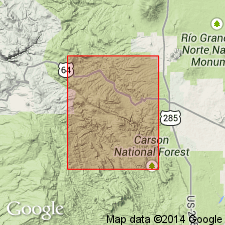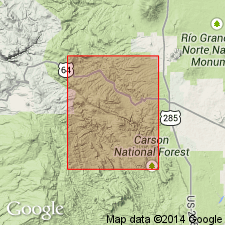
- Usage in publication:
-
- Jawbone conglomerate member
- Modifications:
-
- Original reference
- Dominant lithology:
-
- Conglomerate
- AAPG geologic province:
-
- Southern Rocky Mountain region
Summary:
Pg. 1, 10, 25, pl. 1. Jawbone conglomerate member of Kiawa Mountain formation. Mostly quartz-pebble conglomerate with varying amounts of interlayered gray quartzite. The pebbles are light-gray, red, and black quartz, range from 4 to 25 mm in size, and are moderately well sorted, very well rounded, and mostly ovoid in shape. Granules and coarse grains of sand about as abundant as the pebbles. Matrix of conglomerate mostly blue-gray vitreous fine-grained kyanitic quartzite with hematitic layers. Cross-bedding widespread. Some conglomerate is dark gray and slightly micaceous. Thickness on Jawbone Mountain at least 500 feet and perhaps as much as 2,000 feet; about 500 feet in canyon 1 mile southwest of Hopewell, and from there southeastward member appears to finger out into [lower] quartzite member. Underlies [lower] quartzite member and overlies Moppin series (new) from about 1.5 miles west-northwest of Burned Mountain northwestward for several miles to west boundary of quadrangle. [Relation to Big Rock conglomerate member (new) of Kiawa Mountain not discussed.] Age is Precambrian.
Underlies Jawbone Mountain in extreme northwest corner of Las Tablas quadrangle [Burned Mountain and East Gavilan Canyon 7.5-min quadrangles, Rio Arriba Co., Carson National Forest area, central northern NM]. Also mapped in small area about 1.5 mi northwest of Burned Mountain.
[Additional locality information from USGS historical topographic map collection TopoView, accessed June 8, 2014.]
Source: US geologic names lexicon (USGS Bull. 1200, p. 1914-1915); supplemental information from GNU records (USGS DDS-6; Denver GNULEX).

- Usage in publication:
-
- Jawbone Conglomerate Member*
- Modifications:
-
- Principal reference
- Adopted
- AAPG geologic province:
-
- Southern Rocky Mountain region
Summary:
Pg. A10, A21, A22. Jawbone Conglomerate Member of Kiawa Mountain Formation of Barker (1958). Rocks previously included in Just's (1937) Ortega Quartzite. Consists of pebble conglomerate, fine-grained conglomerate, and quartzite. Because this member is folded, its thickness may not be directly measured; however, it probably is at least 500 feet thick and may be more than 2,000 feet thick. Is basal member of Kiawa Mountain Formation. Overlies Ortega Quartzite (restricted). Stratigraphic relations to Big Rock Member of Kiawa Mountain is not known; there is a possibility that the Jawbone is younger than the Big Rock (see Barker, 1958, pl. 1). Age is Precambrian. (Jawbone Conglomerate Member of Kiawa Mountain Formation adopted by the USGS.)
Type locality: [southwest flank of Jawbone Mountain], in N/2 sec. 19, T. 29 N., R. 7 E., Burned Mountain 7.5-min quadrangle, Rio Arriba Co., [Carson National Forest area], central northern NM.
Source: Publication.

- Usage in publication:
-
- Jawbone Conglomerate Member*
- Modifications:
-
- Age modified
- AAPG geologic province:
-
- Southern Rocky Mountain region
Summary:
Age changed from Precambrian to Proterozoic X. Is younger than Burned Mountain Rhyolite of 1,750 to 1,800 m.y. and older than Maquinita Granite of 1,700 and 1,750 m.y. Mapped with an unnamed quartzite unit that includes Jawbone Conglomerate Member of Kiawa Mountain Formation and an upper quartzite member in report area, Southern Rocky Mountain region.
Source: GNU records (USGS DDS-6; Denver GNULEX).

- Usage in publication:
-
- Jawbone Conglomerate Member*†
- Modifications:
-
- Abandoned
Summary:
Kiawa Mountain Formation and its Jawbone Conglomerate Member are abandoned. The vitreous quartzite at Kiowa Mountain is the Ortega Quartzite. The quartz-pebble conglomerate at Jawbone Mountain is part of the Ortega. The Proterozoic Kiawa Mountain and the Jawbone were known in Rio Arriba Co, NM in the Southern Rocky Mountain region.
Source: GNU records (USGS DDS-6; Denver GNULEX).
For more information, please contact Nancy Stamm, Geologic Names Committee Secretary.
Asterisk (*) indicates published by U.S. Geological Survey authors.
"No current usage" (†) implies that a name has been abandoned or has fallen into disuse. Former usage and, if known, replacement name given in parentheses ( ).
Slash (/) indicates name conflicts with nomenclatural guidelines (CSN, 1933; ACSN, 1961, 1970; NACSN, 1983, 2005, 2021). May be explained within brackets ([ ]).

